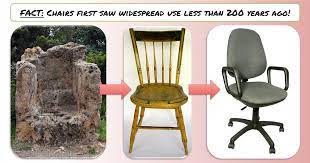The History of First Chair, Here I was, interviewing the architect Witold Rybczynski about his new book, an appreciation of the chair and its 5,000-year history, and I was doing it from a standing desk. Nearby, I had a perfectly tolerable chair, with snazzy features like a mesh-fabric seat, pneumatic seat-height adjustment, and polyurethane armrests. But it wasn’t looking so appealing, perhaps because the American Heart Association had just ruined chairs for me by advising people to sit less and move more, so as to avoid diabetes and cardiovascular disease. I asked Rybczynski if he felt the chair was unfairly maligned in the Age of Standing Desks and Office Exercise Balls.
“I really don’t think we’re in the age of the standing desk,” Rybczynski responded. “I think it’s a fad which will come and go. People have always worked standing up—Winston Churchill, Ernest Hemingway.” (Treadmill desks, in Rybczynski’s book, are summarily dismissed as “silly.”) Today’s health warnings, he added, are about breaking up lengthy periods of sitting with movement, not about chairs themselves.
Rybczynski decided to write about the chair in part because it uniquely combines fashion and functionality. He was also struck by the fact that, unlike weaponry or communications technology, chairs don’t necessarily get “better” over time. “If you’re sitting in a Windsor chair, that’s the same chair, for all practical purposes, that George Washington and Benjamin Franklin sat in,” he said. “Nothing else from that time, other than the [U.S.] Constitution, has survived [in such usable form].” The history of the chair, in other words, is less evolutionary than it is cultural. “The way we choose to sit, and what we choose to sit on, says a lot about us: our values, our tastes, the things we hold dear,” Rybczynski writes in his book, Now I Sit Me Down. You are how you sit.
“An old model of a chair can be just as useful as it ever was,” he told me. “And that really sets it apart from most or at least many technologies, like, say, a smartphone, which changes every year. An old smartphone in 20 years will be just a curiosity. It won’t have any functional purpose.” (Of course, not all sitting furniture is functionally timeless. Imagine eating pasta one-handed while reclining on an ancient Roman dining couch. It helped that wealthy Romans had servants.)
The first chair Rybczynski was able to identify in the historical record was not a physical chair but a sculpture of one from the Cycladic islands in the Aegean Sea, dated to the period 2,800 – 2,700 B.C. The figurine depicts a musician playing a harp while sitting in what looks like a typical kitchen chair, with a straight back and four legs. By the time of the ancient Egyptians, sitting was a matter of status: Everyone sat on stools or on the ground, but chairs with backs or armrests were reserved for the elite.
In the fifth century B.C., the Greeks invented the klismos, which featured curved legs and a curved backrest, and which Rybczynski described to me as “one of the most beautiful chairs made by anybody.” Ever. In his book, he argues that chairs “of equal elegance” to the klismos didn’t emerge for more than 2,000 years, until the “golden age” of chairs in the 18th century, when a flurry of creative craftsmanship and global trade produced ornate items like the French Louis XV armchair and Chinese/English cabriole-legged furniture.
In ancient Greek art, “virtually everybody [is] sitting in a klismos chair. We have women, men, gods, and clearly important people, musicians, workers,” Rybczynski told me. It was a comfortable, “democratic chair,” not a throne. The klismos is also mysterious: It appeared out of nowhere, with a design that was original rather than a variation on a past style, and then disappeared for millennia, only to reemerge as part of the Greek Revival movement in the late 18th and early 19th centuries.

The fifth-century tombstone of Xanthippos, a Greek shoemaker. He’s sitting—comfortably, one imagines—on a klismos. (Wikimedia)
In the Middle Ages, sitting was once again socially stratified. (This back-and-forth between democratic and hierarchical sitting customs has been occurring throughout history. Compare the executive, manager, and secretary chairs of the 1960s with today’s standard-issue, egalitarian Aeron office chair. The technical name for my chair at work is a “Mesh-Back Manager’s Chair,” but it’s not just given to managers.) Ordinary people tended to possess little furniture and sat on whatever was available—a bench, a barrel, the ground. Chairs with arms and backs were reserved for Very Important People. The 16th-century Flemish painter Pieter Bruegel the Elder captured these dynamics in his many depictions of peasant life.

The long benches that were common at tables in the Middle Ages, as shown in Bruegel’s “Peasant Wedding.” One man, likely the bride’s father, is sitting in a chair with a back. (Wikimedia)
Today’s iconic chairs include the made-for-TV-watching recliner, the “ergonomic task chair,” and especially the monobloc plastic chair. The latter can be mass-produced and sold cheaply, and has therefore spread rapidly around the world, becoming perhaps the most widely used chair on the planet. The chairs are a reminder of the homogenizing effect of globalization, but they also subtly testify to local innovation, according to Rybczynski. Plastic chairs are rarely imported; instead, manufacturers in developing countries typically buy used plastic-molding equipment from developed countries and make chairs that “have local motifs worked into them. It may be the color of the chair. Often the backs are decorated in ways you might not find if you just go down to Home Depot.”
The future of the chair, Rybczynski writes, may lie somewhere between the ergonomic task chair and the monobloc—“between a chair that can adapt to the widest possible range of postures and body sizes, and an inexpensive chair for the masses.”

A monobloc chair in the destroyed Syrian town of Kobani (Osman Orsal / Reuters)
Rybczynski’s most striking point is that there’s nothing natural, nothing inevitable, about humans sitting on chairs, despite their 5,000-year-plus history. There are two types of people in the world, at least within the remit of Rybczynski’s study: those who sit on the floor and those who sit on chairs. In Now I Sit Me Down, Rybczynski elaborates on the distinction:
In a classic study of human posture around the world [in the 1950s], the anthropologist Gordon W. Hewes identified no fewer than one hundred common sitting positions. “At least a fourth of mankind habitually takes the load off its feet by crouching in a deep squat, both at rest and at work,” he observed. Deep squatting is favored by people in Southeast Asia, Africa, and Latin America, but sitting cross-legged on the floor is almost as common. Many South Asians cook, dine, work, and relax in that position. Sedentary kneeling, that is, sitting on the heels with the knees on the floor, is practiced by Japanese, Koreans, and Eurasians, and also used by Muslims at prayer.
Rybczynski hasn’t been able to identify clear, consistent patterns for why the world cleaved into floor-sitting and chair-sitting cultures. You’d think, for example, that people in cold, wet climates would be more likely to sit on chairs, so as to avoid the unpleasant ground. But the Japanese, who endure frigid winters, have traditionally sat on floor mats, while the ancient Egyptians, who lived in a warm, dry climate, are thought to have invented the folding stool. Nor is chair-sitting necessarily a matter of lifestyle; some nomadic groups move about with collapsible furniture, while others don’t. Nor is it always a product of economic or technological advancement; the prosperous Japanese were long aware that people in other parts of the world sat on chairs—they just chose not to. Some societies, like China, have transitioned from being predominantly floor-sitting cultures to being predominantly chair-sitting cultures. Others, like India, idiosyncratically mix the two approaches.

An Indian woman makes bread. Her shelves are at a low height, which is common in floor-sitting cultures. (Mansi Thapliyal / Reuters)
What Rybczynski did find is that whether you live in a floor-sitting or chair-sitting society has an impact on much more than how you sit. It can influence everything from your clothing to your house layout to your muscle development, he writes:
If you sit on floor mats, you are likely to The History of First Chair develop an etiquette that requires removing footwear before entering the home. You are also more likely to wear sandals or slippers rather than laced-up shoes, and loose clothing that enables you to squat or sit cross-legged. Floor-sitters tend not to use tall wardrobes— The History of First Chair it is more convenient to store things in chests and low cabinets closer to floor level. People who sit on mats are more likely to sleep on mats, too, just as chair-sitters are more likely to sleep in beds. Chair-sitting societies develop a variety of furniture such as dining tables, dressing tables, coffee tables, desks, and sideboards. Sitting on the floor also affects architecture: walking around the house in bare feet or socks demands smooth floors—no splinters—preferably warm wood rather than stone; places to sit are likely to be covered with soft The History of First Chair mats or woven carpets; tall windowsills and very tall ceilings hold less appeal. Lastly, posture has direct physical effects. A lifetime of sitting unsupported on the floor develops muscles not required for chair-sitting, which is why chair-sitters, unaccustomed to sitting cross-legged, soon become uncomfortable in that position. And vice versa. People in India regularly sit up on train seats and waiting-room benches in the cross-legged position, The History of First Chair which they find more comfortable than sitting with feet hanging down.
As Rybczynski suggests, the arc of history doesn’t necessarily bend toward chairs, let alone better chairs. From the klismos to the Aeron to the mat on the floor, though, humans have shared a need to rest their weary feet. Especially after a long day at a standing desk.






